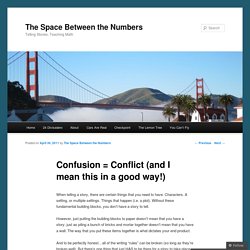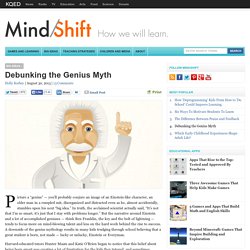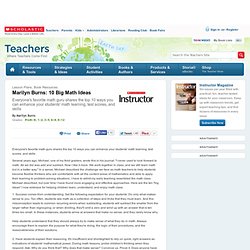

Robyn Brewster
I am an elementary school Math Coach.
Questioning My Metacognition. List of Tweeps and Blogs by Category - welcome to the mathtwitterblogosphere. Math Application for iPad. Inside mathematics - a professional resource for educators / Piketon High School Boys and Girls Basketball Teams present the 2014. The Slow Forty. Prologue act one 1.

How fast do you think Rich Eisen runs in miles per hour? 2. Write a guess. 3. Act three video — the answer sequel. Bucky the Badger. Prologue act one 1.

Guess how many pushups Bucky had to do over the entire game. 2. Pyramid of Pennies. Nana's Paint Mixup. Circle-Square. Dandy Candies. Money Duck. Nana's Lemonade. Coin Counting. Dan Meyer's Three-Act Math Tasks. Confusion = Conflict (and I mean this in a good way!) When telling a story, there are certain things that you need to have.

Characters. A setting, or multiple settings. Things that happen (i.e. a plot). Without these fundamental building blocks, you don’t have a story to tell. However, just putting the building blocks to paper doesn’t mean that you have a story; just as piling a bunch of bricks and mortar together doesn’t mean that you have a wall. And to be perfectly honest…all of the writing “rules” can be broken (so long as they’re broken well). Conflict. A story without conflict is like a bird without wings. I’m sure we’ve all read stories that were boring. I believe in my heart that math teaching can draw from and be informed by storytelling. Right now, in the interwebs, there has been some amazing thinking and talking going on about the role of confusion in the classroom. But for a storyteller, this methodology makes perfect sense. Think about the basic structure of a story: Alice is innocently minding her own business, when WHAM!
Asking students to choose their own path and justify it. Visual Patterns - 1-20. Estimation 180 - Home. Agree or Disagree? - Home. Math Mistakes « MissQuinnMaths. Socrative Student. SonicPics. ZipGrade - Grade Paper Tests and Exit Tickets. TAPit Free. Subtext. Nearpod. Hero new04a.jp. A Lever and a Place to Stand.
Dy/dan. Classroom Friendly Supplies. Practice Tests. The Spring 2014 release consisted of Performance-Based Assessment tests in English Language Arts/Literacy and End-of-Year tests in mathematics. What's available: Grades 3–11 Performance-Based Assessment tests for ELA Grades 3–8 End-of-Year tests for mathematics Algebra I, Geometry, and Algebra II End-of-Year tests for mathematics Notes about scoring: The Spring 2014 release has scoring capability built into the tool.
Practice Tests. THE PRACTICE TESTS. Youtube. Youtube. Analyzing PARCC Performance Level Descriptors Grades 3-5 Part 1. A tutorial on how to successfully take the PARCC test. Sheldon best number. Diagnostic Questions. Mathalicious. Rich Tasks. Christopher Emdin: Hip-Hop and the Remix of Science Education. Robyn Brewster Math Coach. Grade_6_Math_Model_Curriculum_October2013-pdf.pdf.aspx. Grade_4_Math_Model_Curriculum_October2013.pdf.aspx. Kindergarten-Model-Curriculum-Math-Master-May-2014_CG.pdf.aspx. Grade_1_Math_Model_Curriculum_May-2014.pdf. Grade_3_Math_Model_Curriculum_October2013-1.pdf.aspx.
Grade_2_Math_Model_Curriculum_October2013.pdf.aspx. The Hunt Institut. Mathematics Fluency: A Balanced Approach. The Importance of Mathematics Progressions. Mathematical Practices, Focus and Coherence in the Classroom. The Mathematics Standards: Key Changes and Their Evidence. The Mathematics Standards: How They Were Developed and Who Was Involved. CCSS_Video_User_Guide_FINAL_for_upload.pdf. Ccss_progression_cc_oa_k5_2011_05_302.pdf. Ccss_progression_cc_oa_k5_2011_05_302.pdf. IM Log. Shifts in mathematics based on the CCSSM. Debunking the Genius Myth. Picture a “genius” — you’ll probably conjure an image of an Einstein-like character, an older man in a rumpled suit, disorganized and distracted even as he, almost accidentally, stumbles upon his next “big idea.”

In truth, the acclaimed scientist actually said, “It’s not that I’m so smart, it’s just that I stay with problems longer.” But the narrative around Einstein and a lot of accomplished geniuses — think Ben Franklin, the key and the bolt of lightning — tends to focus more on mind-blowing talent and less on the hard work behind the rise to success. A downside of the genius mythology results in many kids trudging through school believing that a great student is born, not made — lucky or unlucky, Einstein or Everyman. Harvard-educated tutors Hunter Maats and Katie O’Brien began to notice that this belief about being born smart was creating a lot of frustration for the kids they tutored, and sometimes unwittingly reinforced by their parents. Related. There’s one key difference between kids who excel at math and those who don’t. “I’m just not a math person.”

We hear it all the time. And we’ve had enough. Because we believe that the idea of “math people” is the most self-destructive idea in America today. The truth is, you probably are a math person, and by thinking otherwise, you are possibly hamstringing your own career. Worse, you may be helping to perpetuate a pernicious myth that is harming underprivileged children—the myth of inborn genetic math ability. Is math ability genetic? How do we know this? Educational technology’s next move: Tools to help kids learn with their bodies.
Photo by Ryan Anson/AFP/Getty Images Today’s educational technology often presents itself as a radical departure from the tired practices of traditional instruction.

But in one way, at least, it faithfully follows the conventions of the chalk-and-blackboard era: EdTech addresses only the student’s head, leaving the rest of the body out. Treating mind and body as separate is an old and powerful idea in Western culture. But this venerable trope is facing down a challenge from a generation of researchers—in cognitive science, psychology, neuroscience, even philosophy—who claim that we think with and through our bodies.
Even the most abstract mathematical or literary concepts, these researchers maintain, are understood in terms of the experience of our senses and of moving ourselves through space. This perspective, known as “embodied cognition,” is now becoming a lens through which to look at educational technology. The Big Bang Theory - Back To The Future Grammar. The Big Bang Theory - Off Topic. The Big Bang Theory - The Friendship Algorithm. The Big Bang theory - Sheldon's superman theory. Do The Math Now! for Grades 6 and u. Marilyn Burns: 10 Big Math Ideas. Everyone's favorite math guru shares the top 10 ways you can enhance your students' math learning, test scores, and skills Several years ago, Michael, one of my third graders, wrote this in his journal: "I never used to look forward to math.

All we did was add and subtract. Now I like it more. We work together in class, and we still learn math but in a better way. " In a sense, Michael described the challenge we face as math teachers-to help students become flexible thinkers who are comfortable with all the content areas of mathematics and able to apply their learning to problem-solving situations. 1. 2. 3. 4. 5. Tyler DeWitt: Hey science teachers. Ramsey Musallam. Rita Pierson: Every kid needs a champion. TED. Neversay.pdf. Mathwire.com. Home Page.
Teachers Primary Pupils Secondary Students Events and PD "It gave me some good ideas to use in the classroom and ... a link that I can get all of the activities from.

" Book NRICH Bespoke PDBook Forthcoming EventsBook our Hands-on Roadshow Your Solutions. Teach Eureka Video Serie. Hom. Achievethecore.org. What is Universal Design for Learning. Universal Design for Learningis a set of principles for curriculum development that give all individuals equal opportunities to learn.

UDL provides a blueprint for creating instructional goals, methods, materials, and assessments that work for everyone--not a single, one-size-fits-all solution but rather flexible approaches that can be customized and adjusted for individual needs. Why is UDL necessary? Individuals bring a huge variety of skills, needs, and interests to learning. Neuroscience reveals that these differences are as varied and unique as our DNA or fingerprints. Three primary brain networks come into play: Recognition Networks The "what" of learning. Piketon High School Boys and Girls Basketball Teams present the 2014. RailsideSummary.pdf.